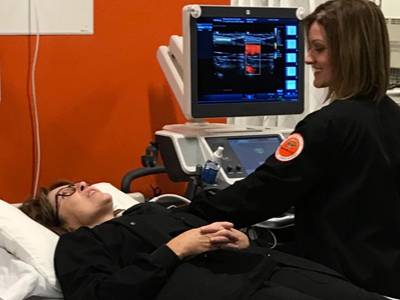Cardiovascular Sonography

About the Cardiovascular Sonography Program
Benefits of an OSU-OKC Cardiovascular Sonography Degree:
- Nationally accredited (CAAHEP) Adult Echocardiography program ensures standardized instructional techniques and methodology. Graduates are eligible for national board exams by the American Registry for Diagnostic Medical Sonography (ARDMS) and Cardiovascular Credentialing International (CCI).
- A degree program is preferred by many of the employers across the state.
- Extensive “hands-on” instruction in a university laboratory setting. A faculty member will spend time with each student perfecting their technique.
- Numerous, state of the art Sonography machines, and equipment is available for student practice/training in the department’s Sonography laboratory.
- Training in stress cardiovascular sonography and transesophageal echocardiography.
- Specialized training: All required student clinical rotations specialize in cardiovascular sonography. The entirety of student education is spent in the cardiovascular sonography specialty, therefore providing the student with specialized didactic and sonography scanning abilities.
Admission to the Cardiovascular Sonography program is based on a points system. One class is admitted to the program every academic year. Up to 22 students are admitted each year with the applicant pool varying from 80 to 150 applications. The actual accepted number is commensurate with the number of clinical rotation sites available to offer the students.
The following factors are considered as part of the final selection into the program:
- Background Check: Must be completed through the designated vendor only. Admission may be denied to applicants with a criminal history or to those who submit false information.
- GPA Requirement: A minimum cumulative GPA of 2.5 from all previous college-level coursework is required.
- TEAS-ATI Test: A current Pre-Admission TEAS (Test of Essential Academic Skills) score is required.
- Prerequisite Coursework: Completion of all required prerequisite or equivalent courses with a grade of C or higher.
- Recommendation and Personal Achievement letters
- Vaccination/Immunization Records: Proof of pre-clinical immunizations as outlined in the Student Handbook.
- Drug Screening: A negative 10-panel urine drug screen conducted through the designated vendor only.
- Technical Standards: Applicants must meet the program’s established technical standards.
- Additional Pre-Clinical Documentation required:
- Campus-Wide Student ID (CWID)
- American Heart Association BLS CPR certification
- Valid driver’s license and REAL ID
- Social Security card
- Current USCIS or U.S. Department of State documentation (if applicable)
- Health insurance card
- Vehicle information (make, model, and license plate number)
- Completed orientation and handbook acknowledgment forms
- Completed Human Resources forms
- Any additional onboarding documentation required by clinical sites
JOB FACT FILE
Certified Diagnostic Medical Sonographers with an associate degree earn an average of $71,810 annually with 110 new positions each year, according to the Oklahoma Long-Term Occupational Outlook, 2020-2030 ok-occupational-employment-projections-2020-2030.pdf (oklahoma.gov). According to the Bureau of Labor and Statistics, overall employment of diagnostic medical sonographers and cardiovascular technologists and technicians is projected to grow 10 percent from 2021 to 2031, faster than the average for all occupations. About 10,100 openings for diagnostic medical sonographers and cardiovascular technologists and technicians are projected each year, on average, over the decade https://www.bls.gov/ooh/healthcare/diagnostic-medical-sonographers.htm.